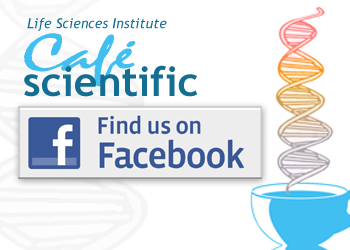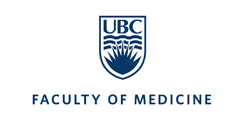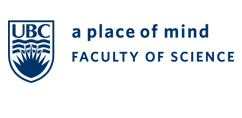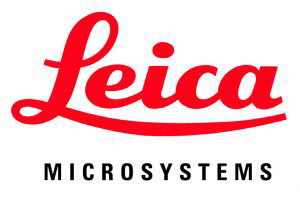 On April 30, 2013, the Life Sciences Institute (LSI) at the University of British Columbia hosted the 12th LSI Café Scientifique. Over 60 interested community members, students and faculty gathered for an informal and participatory dialogue with LSI experts for the fifth session in the “Seeing Is Believing” series. The topic of the session was “Super-Resolution Microscopy: Breaking the Diffraction Barrier”.
On April 30, 2013, the Life Sciences Institute (LSI) at the University of British Columbia hosted the 12th LSI Café Scientifique. Over 60 interested community members, students and faculty gathered for an informal and participatory dialogue with LSI experts for the fifth session in the “Seeing Is Believing” series. The topic of the session was “Super-Resolution Microscopy: Breaking the Diffraction Barrier”.
The Café featured Dr. Ivan Robert Nabi, member of the Cell & Developmental Biology (CELL) Research Group and Department of Cellular & Physiological Sciences and Dr. Keng-Chang Chou from the Department of Chemistry.
Since the invention of compound microscope in 1590 by Zaccharias Janssen and his son Hans, microscopy has made great  contributions to the advancement of science. In the past 50 years, scientists have used a technique called “fluorescence microscopy” to observe the inner working of cells. In this technique, a light beam illuminates proteins marked with a fluorescent tag. By providing a glimpse of what goes wrong inside cells affected by disease, this technology has driven many important advances in biomedical research. Conventional fluorescence microscopy reveals many cellular features, but the tiniest structures – those that allow cells to communicate with each other and the outside environment – have been hidden in the haze caused by the diffraction of light (i.e. the diffraction barrier). The effect of light diffraction limits the resolution of an optical microscope to approximately half of the wavelength of light used. With the best optics, the resolution of fluorescence microscopy is limited to ~ 200 nanometres (nm), which cannot resolve many fine cellular structures.
contributions to the advancement of science. In the past 50 years, scientists have used a technique called “fluorescence microscopy” to observe the inner working of cells. In this technique, a light beam illuminates proteins marked with a fluorescent tag. By providing a glimpse of what goes wrong inside cells affected by disease, this technology has driven many important advances in biomedical research. Conventional fluorescence microscopy reveals many cellular features, but the tiniest structures – those that allow cells to communicate with each other and the outside environment – have been hidden in the haze caused by the diffraction of light (i.e. the diffraction barrier). The effect of light diffraction limits the resolution of an optical microscope to approximately half of the wavelength of light used. With the best optics, the resolution of fluorescence microscopy is limited to ~ 200 nanometres (nm), which cannot resolve many fine cellular structures.
Now, a revolutionary breakthrough has created a new type of microscope that cuts through this haze, breaking the diffraction barrier and bringing the tiniest cellular structures into sharp focus. Called “super-resolution” microscopy, this game-changing technology allows researchers to observe structures as small as 20 nm – just ten times the size of the largest proteins – and track them over time within a living cell. Stimulated emission depletion (STED) imaging uses a second doughnut-shaped laser beam to shrink the effective size of the imaging laser, lighting up a smaller region of fluorescent proteins. This provides outstanding lateral resolution of 50-70 nm, and rapid imaging in three dimensions without need for complex mathematical interpretation of the data. Localization microscopy approaches are based on the repeated activation of small numbers of discrete fluorophores whose precise localization is determined using a Gaussian fit of the point-spread function (PSF). Repeated activation of samples generates images whose X-Y resolution is on the order of 20 nm.
barrier and bringing the tiniest cellular structures into sharp focus. Called “super-resolution” microscopy, this game-changing technology allows researchers to observe structures as small as 20 nm – just ten times the size of the largest proteins – and track them over time within a living cell. Stimulated emission depletion (STED) imaging uses a second doughnut-shaped laser beam to shrink the effective size of the imaging laser, lighting up a smaller region of fluorescent proteins. This provides outstanding lateral resolution of 50-70 nm, and rapid imaging in three dimensions without need for complex mathematical interpretation of the data. Localization microscopy approaches are based on the repeated activation of small numbers of discrete fluorophores whose precise localization is determined using a Gaussian fit of the point-spread function (PSF). Repeated activation of samples generates images whose X-Y resolution is on the order of 20 nm.
Super-resolution microscopy represents the next frontier of optical imaging for biological and health research applications. Using CFI-funded infrastructure, the imaging community at UBC will now develop a Super Resolution Core imaging unit to apply live cell super-resolution imaging to disease models.
A mounted image entitled “Caveolae at super-resolution”, supplied by Dr. Nabi, was given away as the door prize to a member of the audience.
the audience.
The LSI Café Scientifique is co-sponsored by the Life Sciences Institute (LSI), Michael Smith Foundation for Health Research (MSFHR), Faculty of Medicine Research Office, Faculty of Science Dean’s Office, the Leica Corporation, the microscope company Systems for Research and Café Perugia (UBC Food Services).
The next Café Scientific that will continue the “Seeing is Believing” series will take place in fall of 2013.
To look at more pictures, please visit our facebook page.
To view the tape recording, please visit our Youtube channel.








